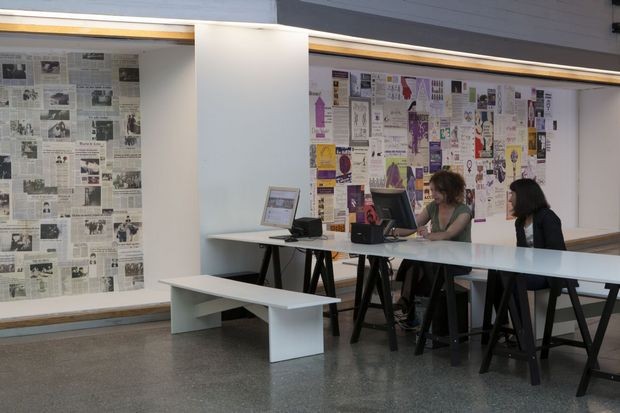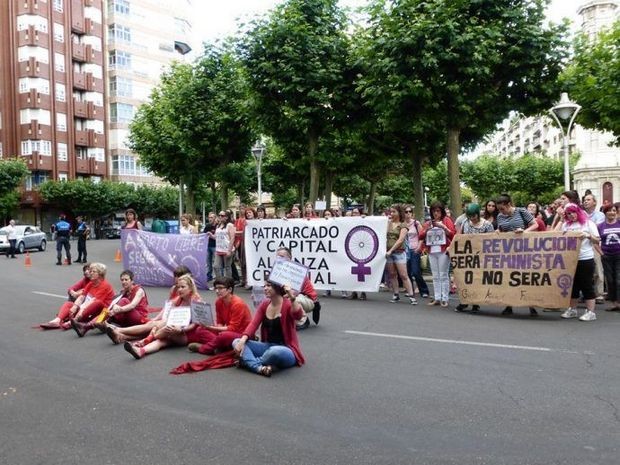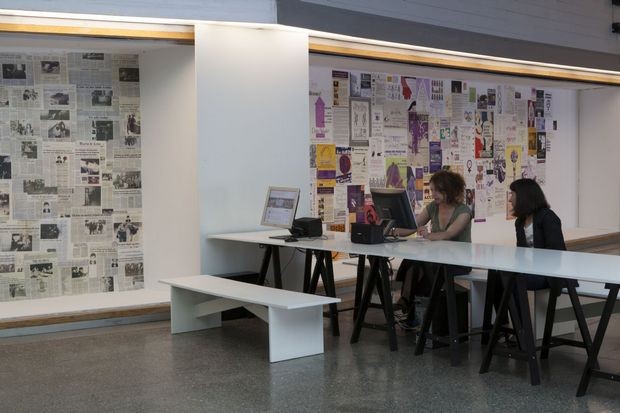Feminisms in León. From CCAN’s Attic to Transfeminist Insubordination
Showcase Project
25 Jun - 27 Nov 2016
FEMINISMS IN LEÓN. FROM CCAN’S ATTIC TO TRANSFEMINIST INSUBORDINATION
Showcase Project
25 June - 27 November 2016
The project Feminisms in León. From CCAN’s Attic to Transfeminist
Insubordination is a journey through the history of the feminist
movement in the province of León consisting of graphic materials and
oral testimonies of the women activists involved in it.
It starts in 2013 with the activation of the Container of Feminisms at the MUSAC, an initiative that was part of the exhibition Feminist Genealogies in Spanish Art: 1960-2010. The Container is a device designed by artists Carme Nogueira, Uqui Permui and Ánxela Caramés to preserve and disseminate documents produced by feminist groups. It is conceived as an installation that becomes an itinerant archive that can be activated in different geographical and temporal contexts.
The feminist movement in Leon appropriated the container generating events and actions that led to the construction of a genealogical archive of the feminist movements of the city, from the 1970s to the present day. It is an in-progress online archive which continues being supplemented with new documents and interviews and to which both feminist associations that have already disappeared and others that have arisen after the activation of the container are being added.
(www.archivofeminismosleon.org)
The archive starts in the decades of the seventies and eighties,
when, after Franco’s death, and during the first years of the so-called
Transition (to democracy), activist groups produced a significant
amount of graphic material. The feminist movement recognized the graphic arts and its aesthetic possibilities as a powerful tool for ideological questioning and dissemination.
Aware of the value of images and signs, they translated their ideas and claims to paper and/or into street actions that most of the times were not documented. Many documents are not signed and remain unattributed, since they were part of collaborative practices in which militancy and collective sense cancelled all attempt at individual authorship.
The predominance of the practice of the do-it-yourself was complemented with the collaboration of female artists, designers and students of Fine Arts, who, sympathising with the feminist cause, contributed to it with their work.
The graphic style used is not so different from the one proposed by other peer groups in Europe or the United States; frequent coincidences are found.
Although it may seem surprising because of the widespread delay resulting of Franco’s dictatorship, the fledgling feminist movement at the state level had similar aspirations and ways of doing to other geographical contexts.
As in other countries, the demands focused on issues related to the autonomy of the female body (especially regarding sexual and reproductive rights), although in this case they had to cope with a very conservative legislation that had barely changed since Franco’s death. The introduction of a divorce law and an amnesty for the more than 350 women who, in 1976, were still in Spanish prisons for the so-called ‘specific offences’ (adultery, abortion and prostitution), were the initial struggles of the feminist movement. These were followed by the decriminalization of contraception, abortion, or the issue of violence against women. Although it still remains unrecognized, the truth is that feminists exerted a decisive influence on the political agenda of Spanish transition to democracy, achieving the repeal of several laws and fighting for the introduction of others.
In 1975, International Women’s Year declared by the UN, when Franco’s dictatorship was in its death throes, the Asociación Leonesa de Mujeres Flora Tristán was created — today it is called Asociación Feminista Leonesa Flora Tristán.
At that time, the attic of the CCAN was a social and political hotbed. Leon’s leftists were camouflaged under the brand of the Club Cultural de Amigos de la Naturaleza [Friends of Nature Cultural Club] in order to mislead the Social-Political Brigade (Francoist social police), which chased anything that didn’t conform to the regime’s official rules. The attic was the place where many and diverse social movements saw the light in Leon.
After 41 years of existence, this association still has an intense activity.
Some associations dedicated to the management of resources such as Simone de Beauvoir (1987) and ADAVAS (1991) originated from the CCAN. Both associations were created by feminists to provide professional and comprehensive support to women suffering sexual and sexist violence through a reception centre and two day centres, at a time when there was neither sensitivity nor interest in taking ownership of these resources in the public administration.
For its part, the Association of Unmarried Mothers Isadora Duncan was founded in 1984 by a group of single mothers, in order to claim and assert their rights in the face of the evident or hidden discrimination suffered by this collective.
The archive and the exhibition record the history of León’s feminisms, their participation in the national feminist struggles (abortion, sexual rights, etc.), as well as those that were specific of the city, from the participation in the national feminist struggles (abortion, sexual rights, divorce) to those that were specific for the city, such as the demonstration in solidarity with the women who were to be judged in Basauri accused of abortion practices (1979), the feminist protests related to the case of the ‘tracksuit rapist’ (1989), the occupation of the cinema Emperador (1989), the ‘Sunless Mondays’ concentrations against gender violence (2005), the invisibility of lesbians in the city, or issues relating to labour rights or coeducation.
New feminist groups emerged in recent years such as Insumisas al patriarcado, Femicletacción and PELOS Feministas are also present in the archive. They bring new perspectives and ensure a generational shift and the continuity of the feminist struggles in the city. These groups combine discussion, reflection and self-training with street actions, and will put on the table the new feminisms and transfeminisms, which add new bodies and new experiences to the feminist agenda.
The exhibition Feminisms in León. From CCAN’s Attic to Transfeminist Insubordination is a collectively produced work that has been set up from different perspectives and with the will to go on growing, since new materials and groups will be added subsequently. It is therefore not a closed or limited project, but an open and ‘in-the-making’ investigation that is taking shape in parallel with feminist struggles.
The online archive contains all digitized graphic material related to these feminist groups of León, associated with descriptive tags that allow a thematic navigation, as well as information on each of the associations and groups of the project.
Other activities related to feminist issues, such as a seminar on the analysis of the history of feminisms in the Spanish state, which will take place on 15th and 16th of July, will be developed in the context of the exhibition. In addition to paying particular attention to the León case, different archives and works produced in different places to revitalize the memory of the feminism movement will be shown and there will be a reflection on the future of feminisms in today’s society
Showcase Project
25 June - 27 November 2016
The project Feminisms in León. From CCAN’s Attic to Transfeminist
Insubordination is a journey through the history of the feminist
movement in the province of León consisting of graphic materials and
oral testimonies of the women activists involved in it.
It starts in 2013 with the activation of the Container of Feminisms at the MUSAC, an initiative that was part of the exhibition Feminist Genealogies in Spanish Art: 1960-2010. The Container is a device designed by artists Carme Nogueira, Uqui Permui and Ánxela Caramés to preserve and disseminate documents produced by feminist groups. It is conceived as an installation that becomes an itinerant archive that can be activated in different geographical and temporal contexts.
The feminist movement in Leon appropriated the container generating events and actions that led to the construction of a genealogical archive of the feminist movements of the city, from the 1970s to the present day. It is an in-progress online archive which continues being supplemented with new documents and interviews and to which both feminist associations that have already disappeared and others that have arisen after the activation of the container are being added.
(www.archivofeminismosleon.org)
The archive starts in the decades of the seventies and eighties,
when, after Franco’s death, and during the first years of the so-called
Transition (to democracy), activist groups produced a significant
amount of graphic material. The feminist movement recognized the graphic arts and its aesthetic possibilities as a powerful tool for ideological questioning and dissemination.
Aware of the value of images and signs, they translated their ideas and claims to paper and/or into street actions that most of the times were not documented. Many documents are not signed and remain unattributed, since they were part of collaborative practices in which militancy and collective sense cancelled all attempt at individual authorship.
The predominance of the practice of the do-it-yourself was complemented with the collaboration of female artists, designers and students of Fine Arts, who, sympathising with the feminist cause, contributed to it with their work.
The graphic style used is not so different from the one proposed by other peer groups in Europe or the United States; frequent coincidences are found.
Although it may seem surprising because of the widespread delay resulting of Franco’s dictatorship, the fledgling feminist movement at the state level had similar aspirations and ways of doing to other geographical contexts.
As in other countries, the demands focused on issues related to the autonomy of the female body (especially regarding sexual and reproductive rights), although in this case they had to cope with a very conservative legislation that had barely changed since Franco’s death. The introduction of a divorce law and an amnesty for the more than 350 women who, in 1976, were still in Spanish prisons for the so-called ‘specific offences’ (adultery, abortion and prostitution), were the initial struggles of the feminist movement. These were followed by the decriminalization of contraception, abortion, or the issue of violence against women. Although it still remains unrecognized, the truth is that feminists exerted a decisive influence on the political agenda of Spanish transition to democracy, achieving the repeal of several laws and fighting for the introduction of others.
In 1975, International Women’s Year declared by the UN, when Franco’s dictatorship was in its death throes, the Asociación Leonesa de Mujeres Flora Tristán was created — today it is called Asociación Feminista Leonesa Flora Tristán.
At that time, the attic of the CCAN was a social and political hotbed. Leon’s leftists were camouflaged under the brand of the Club Cultural de Amigos de la Naturaleza [Friends of Nature Cultural Club] in order to mislead the Social-Political Brigade (Francoist social police), which chased anything that didn’t conform to the regime’s official rules. The attic was the place where many and diverse social movements saw the light in Leon.
After 41 years of existence, this association still has an intense activity.
Some associations dedicated to the management of resources such as Simone de Beauvoir (1987) and ADAVAS (1991) originated from the CCAN. Both associations were created by feminists to provide professional and comprehensive support to women suffering sexual and sexist violence through a reception centre and two day centres, at a time when there was neither sensitivity nor interest in taking ownership of these resources in the public administration.
For its part, the Association of Unmarried Mothers Isadora Duncan was founded in 1984 by a group of single mothers, in order to claim and assert their rights in the face of the evident or hidden discrimination suffered by this collective.
The archive and the exhibition record the history of León’s feminisms, their participation in the national feminist struggles (abortion, sexual rights, etc.), as well as those that were specific of the city, from the participation in the national feminist struggles (abortion, sexual rights, divorce) to those that were specific for the city, such as the demonstration in solidarity with the women who were to be judged in Basauri accused of abortion practices (1979), the feminist protests related to the case of the ‘tracksuit rapist’ (1989), the occupation of the cinema Emperador (1989), the ‘Sunless Mondays’ concentrations against gender violence (2005), the invisibility of lesbians in the city, or issues relating to labour rights or coeducation.
New feminist groups emerged in recent years such as Insumisas al patriarcado, Femicletacción and PELOS Feministas are also present in the archive. They bring new perspectives and ensure a generational shift and the continuity of the feminist struggles in the city. These groups combine discussion, reflection and self-training with street actions, and will put on the table the new feminisms and transfeminisms, which add new bodies and new experiences to the feminist agenda.
The exhibition Feminisms in León. From CCAN’s Attic to Transfeminist Insubordination is a collectively produced work that has been set up from different perspectives and with the will to go on growing, since new materials and groups will be added subsequently. It is therefore not a closed or limited project, but an open and ‘in-the-making’ investigation that is taking shape in parallel with feminist struggles.
The online archive contains all digitized graphic material related to these feminist groups of León, associated with descriptive tags that allow a thematic navigation, as well as information on each of the associations and groups of the project.
Other activities related to feminist issues, such as a seminar on the analysis of the history of feminisms in the Spanish state, which will take place on 15th and 16th of July, will be developed in the context of the exhibition. In addition to paying particular attention to the León case, different archives and works produced in different places to revitalize the memory of the feminism movement will be shown and there will be a reflection on the future of feminisms in today’s society



